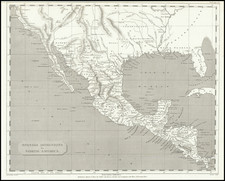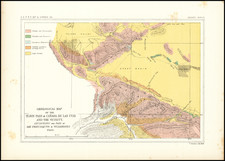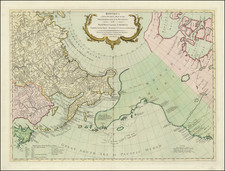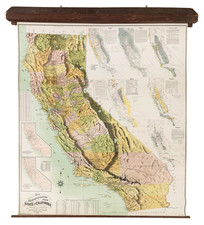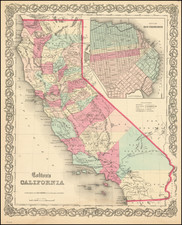Interesting early map and promotional brochure promoting the lines of the North American Transportation and Trading Company to the Gold Regions in Alaska and the Yukon River.
The present map emphasizes the steamship route by sea from San Francisco and Seattle to Iliuliuk or Dutch Harbor on the island of Unalaska in the Aleutian islands, then north to St. Michael's Island and Fort Get There. From there, transit proceeded upon the Yukon River to the Gold Fields, shown in red, via Hamilton Landing, Weare, Rambart City, Ft. Hamlin, Ft. Yukon, Circle City and Dawson at the mouth of the Klondike River, just across the Alaska-Canada border.
Includes an extensive promotional text on the verso, emphasizing the services of the North American Transportation and Training Company.
Klondike and Yukon Gold Rush
The history of the mining boom in the Klondike and Yukon regions begins in 1896. In August 1896, three people led by Keish (Skookum Jim Mason), a member of the Tagish First Nations, headed north, down the Yukon River from the Carcross area, looking for Keish's sister Kate and her husband George Carmack. The party included Skookum Jim Mason, his cousin, known as Dawson Charlie (or sometimes Tagish Charlie), and his nephew Patsy Henderson. After locating George and Kate fishing for salmon at the mouth of the Klondike River, they ran into Nova Scotian Robert Henderson who had been mining gold on the Indian River, just south of the big dike. Henderson told George Carmack about where he was mining and that he did not want any "Siwashes" (meaning Indians) near him.
On August 16, 1896, the Skookum party discovered rich placer gold deposits in Bonanza (Rabbit) Creek, Yukon. The news spread to other mining camps in the Yukon River valley. Gold was first discovered in Rabbit Creek, which was later named Bonanza Creek. The Bonanza, Eldorado, and Hunker Creeks were rapidly staked by miners who had been previously working creeks and sandbars on the Fortymile and Stewart Rivers.
News reached the United States in July 1897, at the height of a significant series of financial recessions and bank failures in the 1890s. The first prospectors arrived in San Francisco, California on July 15 and in Seattle, Washington on July 17, setting off the Klondike stampede. In 1898, the population in the Klondike may have reached 40,000, which threatened to cause a famine.
The boom brought many interesting people, including William Howard Taft (Camp Skagway #1), who went on to become a U.S. President; Frederick Russell Burnham, the celebrated American scout who arrived from Africa only to be called back to take part in the Second Boer War; and W. W. White, author and explorer.
Most prospectors landed at the Alaskan towns of Skagway and Dyea, both located at the head of the Lynn Canal. From these towns they traveled the Chilkoot Trail and crossed the Chilkoot Pass, or they hiked up to the White Pass and then to Lake Lindeman or Bennett Lake, the headwaters of the Yukon River. Here, the prospectors built rafts and boats that would take them the final 500-plus miles down the Yukon to Dawson City, near the gold fields.
The miners had to carry a year's supply of goods over the passes to be allowed to enter Canada. At the top of the passes, the miner's met Canada's North West Mounted Police at a post that enforced the provisions regulation, as well as customs and duties. It was put in place to avert shortages like those that had occurred in the previous two winters in Dawson City, and also to restrict the entry of guns, particularly handguns, into British territory. Another reason was to keep out of Canadian territory the criminal element which had established itself in Skagway and the other Yukon Ports (then still claimed as British territory), as well as the fears by British and Canadian authorities about a possible armed takeover of the goldfields as an American territory.
Once the bulk of the prospectors arrived at Dawson City, most of the major mining claims of the region were already established. However, any major potential unrest with the idle population was averted with the firm authority of the North West Mounted Police, under the command of Sam Steele.
Rarity
The map is very rare. There are two states of the map, one with photographs and one without (the Library of Congress example is without photographs). OCLC shows 2 examples, neither of which reference the photographs (Dartmouth and Wisconsin Historical Society).












